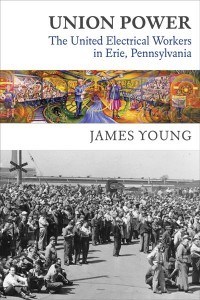Union Power: The United Electrical Workers in Erie, Pennsylvania
264 pp, $29 pbk, ISBN 9781583676172
By James Young
Reviewed by Robert Shaffer for H-Net Reviews in the Humanities & Social Services
Read the review, below, or on H-Net Reviews
The United Electrical, Radio, and Machine Workers of America—the unwieldy name is usually shortened to United Electrical Workers, or UE—occupies a significant niche in the history of the American labor movement. Once the third largest affiliate of the Congress of Industrial Organizations (CIO), with half a million members at its high point, UE represented workers at such iconic manufacturers as General Electric (GE), Westinghouse, and Radio Corporation of America (RCA). CIO leaders accused UE in 1949 of being Communist-dominated, but, unlike most of the left-led unions expelled from the union federation in 1950, UE still exists, albeit on a diminished scale, representing the interests of its members on the shop floor and continuing its brand of progressive unionism.
UE’s story at the national level has been told before, in Them and Us: Struggles of a Rank-and-File Union (1974), by the union’s general secretary James Matles, with James Higgins; The Electrical Workers: A History of Labor at General Electric and Westinghouse, 1923-60, by Ronald Schatz (1983); and Cold War in the Working Class: The Rise and Decline of the United Electrical Workers, by Ronald Filippelli and Mark McColloch (1995). Gerald Zahavi has also described in a series of articles the Schenectady, New York, local. Now James Young has published the first book-length account of the victories and tribulations of UE Locals 506 and 618—the blue-collar and white-collar workers, respectively—at GE’s sprawling Erie Works, in northwestern Pennsylvania. While a community study, Young’s book locates UE’s experience in Erie in a broader national and even international context, and, while following in the main lines of those earlier studies, he unearths new insights through his intensive attention to these two interrelated locals.
Young, professor emeritus at Edinboro University, just a few miles from Erie, draws on extensive interviews with UE activists and their family members, which he conducted decades ago, in the early 1980s, and these alone constitute an important contribution to the historical record. Combining these interviews with his wide reading of union records and sources, Erie’s two newspapers, transcripts of federal investigations into so-called subversive activities, and local and national Catholic publications, Young is able to argue convincingly that while shop-floor Communists from Erie and from the UE staff contributed to the building of Locals 506 and 618, this political faction never controlled these locals, which at their height claimed upward of ten thousand members. Young argues, too, that the locals and their leaders formed an integral part of a broader progressive movement in the region and that most rank-and-file members remained loyal to the union, even when it was under attack from the federal government, the company, the Catholic Church, and other CIO unions.
Some scholars have portrayed the founders of UE in Erie in the 1930s as “conservative,” challenged by more militant and radical younger workers in the 1940s whose views were more in line with the union’s national leaders. Young revises that picture, demonstrating instead that several of the founders came from Socialist, anti-racist, or otherwise strong union backgrounds in the area. (Indeed, Young tells us, Progressive presidential candidate Robert LaFollette ran ahead of the Democrats in Erie County in 1924.) Young also shows that when James Kennedy, who all agree was the key figure in bringing UE to Erie, ran for US Congress as a Democrat in 1948, when much of UE backed another short-lived Progressive Party, he remained on good terms with supporters of Henry Wallace within and outside his union and received left-wing support for his unsuccessful campaign. Moreover, these supposedly “conservative” activists stood up forthrightly in the late 1940s and early 1950s against unrelenting government and company efforts to pressure them to renounce radicalism and to abandon UE for its vehemently anti-Communist competitor, the International Union of Electrical, Radio, and Machine Workers (IUE). Given the fact that at times its Erie membership constituted about 10 percent of UE’s overall total, Young concludes, reasonably, that the loyalty that Erie’s workers showed to UE in the face of IUE certification challenges in the 1950s was ultimately key to UE’s ability on a national level to survive what UE leader Matles called “the dirty decade” (p. 175).
Despite this survival, Young not surprisingly concludes that McCarthy-era repression hampered UE’s ability to serve its members and to advance a progressive social agenda: “If an aim of the inquisition and related activities was to bind working people and their representatives into a straitjacket of timidity, conformity, and passivity, that goal was at least partly achieved” (p. 174). Indeed, even the structure of Young’s book shows this impact. After one chapter on the founding of the two Erie UE locals in the late New Deal, and a second one on their consolidation during World War II and the subsequent national strike wave of 1946, there follow four chapters cataloguing one assault after another on the union (“The Gathering Storm,” “Fighting for Democracy,” “Fighting for Democracy: Round Two,” and “Fighting for Life”). Young then covers the late 1950s, 1960s, and 1970s in a single twenty-five-page chapter, which narrates the transition to new leadership, the rebirth of militancy against GE in the company-wide 1969-70 strike (during which UE and IUE finally cooperated), and the continued participation of Erie UE activists in social justice movements in and beyond the workplace, especially the civil rights and anti-Vietnam War movements. A brief epilogue, in addition to providing an overall appreciation of UE’s role in Erie, recounts the locals’ partially successful efforts to keep manufacturing jobs in Erie through the 1990s, only to succumb to mass layoffs in the wake of the 2008 Great Recession as part of manufacturing’s globalization.
Because Young’s central contention is that UE’s Erie locals retained the loyalty of their members since they were rooted in the community, he details the nature of those connections between union activists and members, especially in the founding and consolidation years, with regard to ethnicity, religion, and residence, and, to a lesser extent, gender and job duties. (There were few African American residents of Erie or workers at its GE plants before the 1960s.) For example, the author details the myriad ways UE and other unions in 1946 provided for their striking members by mobilizing wider community support. He identifies a “moral economy” ideology that motivated activists, even drawing on the Catholic Church’s historic critique of capitalism for the predominantly Catholic workforce. On the other hand, Young explores in depth the opposition to left-wing unionism in the city’s newspapers and especially in the Catholic hierarchy. Among the most powerful sections of Union Power is Young’s dissection of the worldview of the Erie Catholic diocese, ranging from its pre-World War II flirtations with Fascism in Spain and Italy to its virulent antiCommunism to its conflation, at times, of labor and Communism. But Young is careful to note countervailing tendencies even among local Catholic leaders, such as the searing critique of the 1947 Taft-Hartley Act by the “progressive and pro-labor” Professor C. J. Treacy of Erie’s Villa Maria College (now part of Gannon University).
In the course of his attention to UE’s efforts to raise wages and to empower workers on the shop floor, Young devotes special attention to this union’s consistent campaign from the 1940s to the 1970s to end GE’s wage discrimination against women. The campaign, designed more by the national union than by the Erie locals themselves—which, Young states, had relatively low levels of women in leadership positions—first sought to eliminate blatantly reduced wages for women doing the same jobs as men, and then it introduced demands for what would come to be called “comparable worth.” Young appropriately credits UE staffer Betty Friedan—later to become a feminist icon—for helping to coordinate this work in the 1940s, using company practices in Erie as a target, and he notes that the settlement of the 1970 GE strike hinged on a UE formula to raise women’s pay.
Young, a veteran union activist himself, makes clear from the outset that his scholarship emerges from a standpoint similar to UE’s: “This author,” he writes, “believes that working people almost always improve their lives once they organize themselves into labor unions…. In a similar vein, I view the splintering of American labor over the question of political loyalties in the 1948-55 period to have constituted a short-sighted act of fratricide that has weakened the body of organized labor ever since” (p. 14). Young is a fluent and at times biting writer, punctuating his prose with comments that bring out the contemporary ramifications of issues under consideration. After discussing the editorial attacks by the Erie Daily Times on President Harry Truman’s plans for national health insurance as Soviet-inspired, Young adds: “Such avoidance of the merits of a national health program by associating the idea with the devils on the left would serve the opponents of national health insurance for decades to come” (p. 87). While I am sympathetic to Young’s approach, one could question whether UE, as a national union, was too categorical in its rejection of Truman in the 1948 elections, given his veto of Taft-Hartley and his views, say, on this very same question of national health insurance.
Alongside its many strengths, there are several weaknesses in Union Power. First, readers get almost no sense of what day-to-day life was like on the shop floor for these UE members at GE’s Erie Works. What was produced, and when? How many workers were on assembly lines, and how many were in more skilled occupations? There are stray remarks about the “refrigeration unit” and, later, about locomotives, but Young does not integrate the methodology of the no longer “new labor history” about work itself into his analysis. Second, and related to that first point, Young does not systematically trace the impact of the outsourcing of production and the decline, gradual or precipitous, in the workforce at Erie. While Young does a good job at describing the ethnic, religious, and political backgrounds of the earliest groups of union activists, he pays inadequate attention to these factors after World War II. Discussions of gender, race, education, and residence, and the integration of veterans of the Korean and Vietnam Wars would provide a broader view of the membership after 1950, which in turn might even deepen our sense of the achievement of the local union leaders as the burst of New Deal activism faded. One wishes, for example, that Young had interviewed in the early 1980s the newer generation of shop stewards, and not just the old-timers. Increased investigation of such issues in Erie would have allowed Young to be more successful at achieving his own primary goal, “to create a usable past out of the dynamic history of the UE locals and their members at General Electric’s Erie Works” (p.15).
—Robert Shaffer
Shippensburg University


Comments are closed.